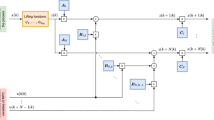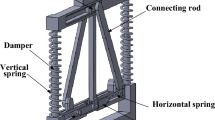Abstract
It is commonly known that the design of control is difficult for the systems with non-minimum phase behavior, the coupling between the controlled variables and integral instability. The paper presents such a typical class of nonlinear system and propose a new technique generalized extended state observer-based sliding mode decoupling control. The proposed control algorithm is also able to compensate for the matched and mismatched uncertainties encountered in such nonlinear non-minimum phase systems. The decoupling control approach is used to decouple the entire system framework into subsystems. The sliding surface of the individual subsystem was composed using the estimated states of GESO. The proposed technique can nullify the effect of external disturbances, parametric uncertainties and unmodelled dynamics due to the inclusion of disturbance compensation gain in the control law. The proposed methodology enables the system to accomplish asymptotic stability and better dynamic response with lesser IAE and ITAE values than existing decoupling control strategies. An experimental application of the proposed technique to Quanser’s rotary pendulum module is investigated.












Similar content being viewed by others
References
Xie Liang-Liang, Guo Lei (2000) How much uncertainty can be dealt with by feedback? IEEE Trans Automatic Control 45(12):2203–2217
Gao Zhiqiang (2014) On the centrality of disturbance rejection in automatic control. ISA Trans 53(4):850–857
Chen WH, Yang J, Guo L, Li S (2016) Disturbance observer based control and related methods :an overview. IEEE Trans Ind Electr 63(2):1083–1095
Utkin V (1977) Variable structure systems with sliding modes. IEEE Trans Autom Control 22(2):212–222
Slotine Jean-Jacques E, Weiping Li (1991) Applied nonlinear control, vol 199. Prentice-Hall Englewood Cliffs, NJ
Hung JY, Gao W, Hung JC (1993) Variable structure control: a survey. IEEE Trans Ind Electr 40(1):2–22
Utkin Vadim I (1992) Sliding modes in control of electric motors. In: Dickinson BW, Fettweis A, Massey JL, Modestino JW, Sontag ED, Thoma M (eds) Sliding modes in control and optimization. Springer, Berlin, Heidelberg, pp 250–264
Kadu CB, Khandekar AA, Patil CY (2018) Sliding mode controller with state observer for tito systems with time delay. Int J Dyn Control 6(2):799–808
Han Ho Choi (2007) LMI-based sliding surface design for integral sliding mode control of mismatched uncertain systems. IEEE Trans Autom Control 52(4):736–742
Johnson CD (1971) Accomodation of external disturbances in linear regulator and servomechanism problems. IEEE Trans Autom Control 16(6):635–644
Wen-Hua Chen, Ballance DJ, Gawthrop PJ, O’Reilly J (2000) A nonlinear disturbance observer for robotic manipulators. IEEE Trans Ind Electr 47(4):932–938
Chen Wen-Hua (2004) Disturbance observer based control for nonlinear systems. IEEE/ASME Trans Mechatr 9(4):706–710
Guo Lei, Chen Wen-Hua (2005) Disturbance attenuation and rejection for systems with nonlinearity via DOBC approach. Int J Robust Nonlinear Control 15(3):109–125
She JH, Fang M, Ohyama Y, Hashimoto H, Wu M (2008) Improving disturbance-rejection performance based on an equivalent-input-disturbance approach. IEEE Trans Ind Electr 55(1):380–389
Han J (1995) Extended state observer for a class of uncertain plants. Control Decis 10(1):85–88
Gao Zhiqiang (June 2006) Active disturbance rejection control: a paradigm shift in feedback control system design. In: American Control Conference, pp 2399–2405
Han Jingqing (2009) From PID to active disturbance rejection control. IEEE Trans Ind Electr 56(3):900–906
Sun D (2007) Comments on active disturbance rejection control. IEEE Trans Ind Electr 54(6):3428–3429
Ren Chao, Ding Yutong, Li Xiaohan, Zhu Xinshan, Ma Shugen (2019) Extended state observer based robust friction compensation for tracking control of an omnidirectional mobile robot. J Dyn Syst Meas Control 141(10):101001
Pawar SN, Chile RH, Patre BM (2017a) Modified reduced order observer based linear active disturbance rejection control for tito systems. ISA Trans 71:480–494
Hua Chang-Chun, Wang Kai, Chen Jian-Nan, You Xiu (2018) Tracking differentiator and extended state observer-based nonsingular fast terminal sliding mode attitude control for a quadrotor. Nonlinear Dyn 94(1):343–354
Talole SE, Kolhe JP, Phadke SB (2010) Extended-state-observer-based control of flexible-joint system with experimental validation. IEEE Trans Ind Electr 57(4):1411–1419
Pawar SN, Chile RH, and Patre BM (Jan 2017b) Design of generalized extended state observer based control for nonlinear systems with matched and mismatched uncertainties. In: Indian Control Conference (ICC), pp 65–71
Min Wu, Pan Yu, Chen Xin, She Jinhua (2017) Design of repetitive-control system with input dead zone based on generalized extended-state observer. J Dyn Syst Meas Control 139(7):071008
Bayramoglu Husnu, Komurcugil Hasan (2013) Nonsingular decoupled terminal sliding-mode control for a class of fourth-order nonlinear systems. Commun Nonlinear Sci Numer Simul 18(9):2527–2539
Yorgancioglu Ferhun, Komurcugil Hasan (2010) Decoupled sliding-mode controller based on time-varying sliding surfaces for fourth-order systems. Expert Syst Appl 37(10):6764–6774
Chen Shi-Yuan, Fang-Ming Yu, Chung Hung-Yuan (2002) Decoupled fuzzy controller design with single-input fuzzy logic. Fuzzy Sets Syst 129(3):335–342
Lo Ji-Chang, Kuo Ya-Hui (1998) Decoupled fuzzy sliding-mode control. IEEE Trans Fuzzy Syst 6(3):426–435
Krafes Soukaina, Chalh Zakaria, Saka Abdelmjid (2018) A review on the control of second order underactuated mechanical systems. Complexity 2018:1–17
Meng Deshan, Wang Xueqian, Wenfu Xu, Liang Bin (2017) Space robots with flexible appendages: Dynamic modeling, coupling measurement, and vibration suppression. J Sound Vibr 396:30–50
Park Kang-Bark, Tsuji Teruo (1999) Terminal sliding mode control of second-order nonlinear uncertain systems. Int J Robust Nonlinear Control 9(11):769–780
Xinghuo Yu, Zhihong Man (2002) Fast terminal sliding-mode control design for nonlinear dynamical systems. IEEE Trans Circuits Systems I Fundamental Theory Appl 49(2):261–264
Feng Yong, Xinghuo Yu, Man Zhihong (2002) Non-singular terminal sliding mode control of rigid manipulators. Automatica 38(12):2159–2167
Hernandez-Mendez A, Linares-Flores J, Sira-Ramirez H, Guerrero-Castellanos JF, Mino-Aguilar G (2017) A backstepping approach to decentralized active disturbance rejection control of interacting boost converters. IEEE Trans Ind Appl 99:1
Yao J, Jiao Z, Ma D (2014a) Adaptive robust control of DC motors with extended state observer. IEEE Trans Ind Electr 61(7):3630–3637
Li S, Liu Z (2009) Adaptive speed control for permanent-magnet synchronous motor system with variations of load inertia. IEEE Trans Ind Electr 56(8):3050–3059
Yao J, Jiao Z, Ma D (2014b) Extended-state-observer-based output feedback nonlinear robust control of hydraulic systems with backstepping. IEEE Trans Ind Electr 61(11):6285–6293
Angu Rittu, Mehta RK (2018) A single machine infinite bus power system excitation control design with extended reduced-order observer. Int J Dyn Control 6(3):1272–1286
Ma Jie, Tao Hao, Huang Jingwen (2020) Observer integrated backstepping control for a ball and plate system. Int J Dyn Control. https://doi.org/10.1007/s40435-020-00629-8
Delibasi A, Kucukdemiral IB, and Cansever G (2007) A robust pid like state-feedback control via lmi approach: An application on a double inverted pendulum system. In: 2007 International Symposium on Computational Intelligence in Robotics and Automation, pp 374–379
Quanser Inc. SRV02-Series Rotary Pendulum User Manual, 2010
Author information
Authors and Affiliations
Corresponding author
Ethics declarations
Conflicts of interest
The authors declare that they have no conflict of interest.
Rights and permissions
About this article
Cite this article
Pawar, S.N., Chile, R.H. & Patre, B.M. Extended state observer based robust sliding mode control for fourth order nonlinear systems with experimental validation. Int. J. Dynam. Control 9, 1600–1611 (2021). https://doi.org/10.1007/s40435-020-00743-7
Received:
Revised:
Accepted:
Published:
Issue Date:
DOI: https://doi.org/10.1007/s40435-020-00743-7




